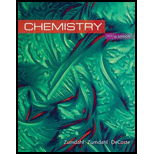
1.
Interpretation: The given questions based upon the properties of noble gases are to be answered.
Concept introduction: The noble gases were among the last elements discovered; their existence was not predicted by Mendeleev when he published his first periodic table because he had not imagined about the noble gases. Hence he did not gave place to noble gases in his first periodic table.
To determine: The answers of various questions based upon properties of noble gases.
2.
Interpretation: The given questions based upon the properties of noble gases are to be answered.
Concept introduction: The noble gases were among the last elements discovered; their existence was not predicted by Mendeleev when he published his first periodic table because he had not imagined about the noble gases. Hence he did not gave place to noble gases in his first periodic table.
To determine: The answers of various questions based upon properties of noble gases.
3.
Interpretation: The given questions based upon the properties of noble gases are to be answered.
Concept introduction: The noble gases were among the last elements discovered; their existence was not predicted by Mendeleev when he published his first periodic table because he had not imagined about the noble gases. Hence he did not gave place to noble gases in his first periodic table.
To determine: The answers of various questions based upon properties of noble gases.
4.
Interpretation: The given questions based upon the properties of noble gases are to be answered.
Concept introduction: The noble gases were among the last elements discovered; their existence was not predicted by Mendeleev when he published his first periodic table because he had not imagined about the noble gases. Hence he did not gave place to noble gases in his first periodic table.
To determine: The answers of various questions based upon properties of noble gases.
5.
Interpretation: The given questions based upon the properties of noble gases are to be answered.
Concept introduction: The noble gases were among the last elements discovered; their existence was not predicted by Mendeleev when he published his first periodic table because he had not imagined about the noble gases. Hence he did not gave place to noble gases in his first periodic table.
To determine: The answers of various questions based upon properties of noble gases.
6.
Interpretation: The given questions based upon the properties of noble gases are to be answered.
Concept introduction: The noble gases were among the last elements discovered; their existence was not predicted by Mendeleev when he published his first periodic table because he had not imagined about the noble gases. Hence he did not gave place to noble gases in his first periodic table.
To determine: The answers of various questions based upon properties of noble gases.
7.
Interpretation: The given questions based upon the properties of noble gases are to be answered.
Concept introduction: The noble gases were among the last elements discovered; their existence was not predicted by Mendeleev when he published his first periodic table because he had not imagined about the noble gases. Hence he did not gave place to noble gases in his first periodic table.
To determine: The answers of various questions based upon properties of noble gases.
Want to see the full answer?
Check out a sample textbook solution
Chapter 20 Solutions
Chemistry
 ChemistryChemistryISBN:9781305957404Author:Steven S. Zumdahl, Susan A. Zumdahl, Donald J. DeCostePublisher:Cengage Learning
ChemistryChemistryISBN:9781305957404Author:Steven S. Zumdahl, Susan A. Zumdahl, Donald J. DeCostePublisher:Cengage Learning Chemistry: An Atoms First ApproachChemistryISBN:9781305079243Author:Steven S. Zumdahl, Susan A. ZumdahlPublisher:Cengage Learning
Chemistry: An Atoms First ApproachChemistryISBN:9781305079243Author:Steven S. Zumdahl, Susan A. ZumdahlPublisher:Cengage Learning
 Chemistry & Chemical ReactivityChemistryISBN:9781337399074Author:John C. Kotz, Paul M. Treichel, John Townsend, David TreichelPublisher:Cengage Learning
Chemistry & Chemical ReactivityChemistryISBN:9781337399074Author:John C. Kotz, Paul M. Treichel, John Townsend, David TreichelPublisher:Cengage Learning General Chemistry - Standalone book (MindTap Cour...ChemistryISBN:9781305580343Author:Steven D. Gammon, Ebbing, Darrell Ebbing, Steven D., Darrell; Gammon, Darrell Ebbing; Steven D. Gammon, Darrell D.; Gammon, Ebbing; Steven D. Gammon; DarrellPublisher:Cengage Learning
General Chemistry - Standalone book (MindTap Cour...ChemistryISBN:9781305580343Author:Steven D. Gammon, Ebbing, Darrell Ebbing, Steven D., Darrell; Gammon, Darrell Ebbing; Steven D. Gammon, Darrell D.; Gammon, Ebbing; Steven D. Gammon; DarrellPublisher:Cengage Learning Chemistry & Chemical ReactivityChemistryISBN:9781133949640Author:John C. Kotz, Paul M. Treichel, John Townsend, David TreichelPublisher:Cengage Learning
Chemistry & Chemical ReactivityChemistryISBN:9781133949640Author:John C. Kotz, Paul M. Treichel, John Townsend, David TreichelPublisher:Cengage Learning





